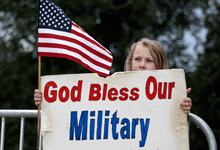Now that the Supreme Court has affirmed Fred Phelps’ and the Westboro Baptist Church’s right to spew anti-gay epithets at military funerals, journalists everywhere need a strategy for covering hate speech.

Audrey Low, 10, of Reston, Va., holds a sign across the street from Arlington National Cemetery while members of the Westboro Baptist Church dance on American Flags. (Carolyn Kaster/AP)
I know this because I spent my formative years as a reporter in the Idaho Panhandle, where Nazis and racist skinheads routinely burned crosses and hosted marches through the middle of beautiful Coeur d’Alene, Idaho at the height of tourist season.
When you give hate speech too much attention, or the wrong kind of attention, you cause more harm than good. Here are some of the common negative affects of hate speech stories that miss the mark:
- You alienate your audience and they turn away.
- Like rewarding a toddler who throws a tantrum, you encourage the speaker to keep talking.
- You embolden others to share their hate speech, so they too can get attention.
- You create a climate, both virtual and real, that fosters screaming instead of civil dialogue.
- You inadvertently pile harm onto innocent individuals who are the target of the speech.
After years of struggling to get it right, we finally figured out some best practices. We didn’t ignore the speech. Instead, we found the appropriate context in which to cover it.
Here are some of the principles we applied. I described them in a story last September about a planned Quran burning in Gainesville, Florida. The principles below are adapted from that piece.
If you are wondering whether or how to cover a hate speech incident, consider these alternatives:
- Don’t go. Unless the location is part of your normal coverage area, or you work for a wire service, look for other ways to get raw material from the event. If it’s big news, there will be plenty of cameras and satellite trucks on hand, as well as amateurs with their Flip cameras. In fact, there are likely to be more journalists than protesters. Will you have access to other material? Then use it, rather than gathering your own and contributing to the circus-like atmosphere.
- Give your audience what it needs to understand the big picture. The moment-to-moment developments will most likely be dull. But even if there is a confrontation or other drama, volumes of pictures or live video footage aren’t likely to enhance anyone’s understanding of what this really means. In fact, because some of these protesters are so isolated in their beliefs, highlighting their actions may make them seem more significant than they are, which distorts the truth.
- Be judicious about the material you publish, especially images. Burning anything in protest or using anti-gay epithets is meant to be offensive. How you use the images can be interpreted as an endorsement or a rejection of the message. Just because you have a lot of material available doesn’t mean you have to publish it.
- Take a stand. If you believe that the protesters are wrong, say so.
- Cover the reaction, not the fanatic. There are some creative responses to lunacy. Mother Jones wrote about a group that rallied people to send a Quran to Afghanistan for every text Pastor Terry Jones burned. Local churches and other organizations planned dozens of events to draw people away from the Quran burning, which was canceled. The response was greater than the event itself would have been. Your coverage should reflect that.
- Talk ahead of time about how you will handle confrontations. A little pushing and shoving can look like a big kerfuffle depending on how you describe it or crop the image. Have a plan to ensure the events are accurately portrayed, so that production work, like creating a video tease or sending out a tweet, doesn’t mislead your audience or undermine your journalistic purpose.
- Help your audience understand why this is hate speech, not a simple protest. Hate speech targets an entire group for a particular characteristic. Some protests are hate speech because they denounce an entire group of people; other protests denounce a certain action or limited set of circumstances. Educate people about the difference.







